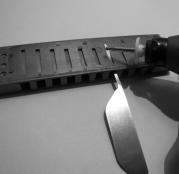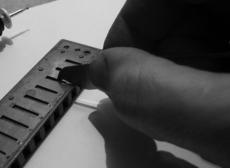Barley Nectar
611 posts
Jan 21, 2015
8:09 AM

|
I am attempting to set up a couple of harps. Have 2 LO's key of D maj. that need tuned. I have never done this before but I understand the mechanical process. I do have a Korg CA-30 chromatic tuner. Found this chart on Lee's site.
http://www.leeoskarquickguide.com/docs/MajorDiatonic-Notation-Chart.pdf
Do I simply tweek the reeds till I get the read to the note shown on the chart or is there more to it. LO's are tuned to 442 I think. Does this enter into the process? Thanks for the help...BN
Last Edited by Barley Nectar on Jan 21, 2015 9:29 AM
|
arzajac
1564 posts
Jan 21, 2015
8:24 AM

|
There's more to it. Notes flatten as we play so you need to tune them to 442 so they sound right when played along with other instruments tuned to 440.
Lower notes flatten more than higher notes, so getting everything to sound right is more complicated than just tuning them according to a chart of offsets.
Here's what I recommend:
Tune a harmonica using your ears and a simple chromatic tuner
----------

Custom overblow harps. Harmonica service and repair.
|
Barley Nectar
619 posts
Jan 25, 2015
8:16 PM

|
OK Andrew, I gave it a try but I cheated. Rather then go thru your whole tuning procedure I simply took a sample pitch reading with my tuner, of a known good LO of the same key. I then tried to raise the errant reed up to that pitch. Using a home made chisel, (soldering tool) I managed to bring the reed up some but broke it. No biggy, the whole plate assembly was tired and a little flat anyhow. LO plates are aprox $22.00 a set and it is like getting a new harp. I did the Vaseline trick upon assembly. Now for a question. I have a Dermal tool. What type of cutter do you use when tuning. The chisel method distorted the reed and changed it's profile so I feel that is not the way to go. I feel the Dermal method has definite advantages. Thank you so much for sharing your knowlage...Goose
|
STME58
1160 posts
Jan 25, 2015
9:40 PM

|
I use toolmakers files and fine sandpaper. It is not as fast as a dremmel but it is a lot harder to accidentally remove too much material.
|
Meaux Jeaux
38 posts
Jan 26, 2015
10:28 AM

|
I don't use rotary tools when tunning or tuning.
|
Gnarly
1219 posts
Jan 26, 2015
10:42 AM

|
I bought a Dremel like rotary tool from Costco 10 years ago (Alltrade) that goes slow enough to use on harps--usually use a polishing bit.
|
barbequebob
2825 posts
Jan 26, 2015
10:51 AM

|
I use a rotary tool that was given to me by a friend of mine who purchased it from the now long defunct F&R Farrell company (the very first snail mail order and later online harmonica specialist store that was THE BEST for many years for buying chromatics) that's similar to one that Seydel had been selling for years. It's super lightweight and simple to use and has on on/off switch that if you leave it in the off position, you squeeze the switch button for momentary on/off that turns on when squeezed and then shuts off immediately when you let it go. It has several different tips, including an ultra fine one that's my go to because it takes very tiny amounts plus you just place it VERY LIGHTLY on the reed. I also make sure that I NEVER use it across the reed diagnolly because altho the reeds tune faster that way (the way Hohner did it for far too long), it tends to quickly weaken the reed in the process.
Even if you don't use a rotary tool, NEVER BE IN A HURRY or you'll wind up doing damage to the reed.
----------
Sincerely,
Barbeque Bob Maglinte
Boston, MA
http://www.barbequebob.com
CD available at http://www.cdbaby.com/cd/bbmaglinte
|
Barley Nectar
622 posts
Jan 26, 2015
12:25 PM

|
Thanks Bob. I just threw away receipts from F&R Farrell yesterday, I still have their paper catalogue here somewhere!
I have pretty good hands and am confident in my ability to control the dermal. Mine has a speed control so that is a +, evidently. I still would like to know what tool to put in the dermal. Is it a rotary file, burr wheel, abrasive ball? Abrasives would probably clog unless designed for brass. Thanks again guys...BN
|
barbequebob
2826 posts
Jan 26, 2015
1:26 PM

|
I don't have a Dremel but I'd want to use one that is as close to ultra fine as possible with a diamond tip because less metal will get removed ad tho it may take somewhat more time, Anything even the slightest more coarse will take off too much (and the only time I'd use a more coarse bit is if I'm retuning a reed with the use of solder on the reed).
----------
Sincerely,
Barbeque Bob Maglinte
Boston, MA
http://www.barbequebob.com
CD available at http://www.cdbaby.com/cd/bbmaglinte
|
Harmonicatunes
4 posts
Jan 26, 2015
2:01 PM

|
Harmonica work is best done with tools designed for the job. The Hohner maintenance kit fits the bill here. In addition, they have tutorial videos on tuning, gapping etc.
Go to http://us.playhohner.com/service/hohner-service/harmonica-service/ for details
----------
Tony Eyers
Australia
www.HarmonicaAcademy.com
everyone plays...
|
arzajac
1572 posts
Jan 26, 2015
3:49 PM

|
" I have a Dermal tool. What type of cutter do you use when tuning."
I own seven rotary tools from various companies. Some are excellent and some are useless. Some of the ones with the smallest TIR (best!) are cheap things from China. How useful they are also depends on how the weight is balanced.
That being said, I don't use a Dremel for tuning. I use a battery-powered diamond tip engraver. Think high-RPM, low-power and lightweight. That's what works for me for tuning. It works much better than Swiss files for me.
There are many ways to get the job done. There is nothing inherently wrong with using files, rotary tools/engravers or sandpaper. Try everything and use what gives you the best results. ...Or not. If you find something that gives you good results and want to stick with it, good for you!
I get asked a lot about the engraver I use in my videos. I get asked about it so often that I posted a few details about it here:
"Where can I get that engraver?"
What tip to use?
If given a choice between two round diamond tips, I would pick one that's not too small, like the one on the left:

----------

Custom overblow harps. Harmonica service and repair.
Last Edited by arzajac on Jan 26, 2015 3:54 PM
|
chromaticblues
1662 posts
Jan 26, 2015
4:05 PM

|
I don't use rotary bits either just because of the aggressiveness of the whole process. Now I'm not saying I couldn't do it that way, but the reason I don't is because If metal needs to be removed why not try to remove the milling marks at the same time. If removing milling marks is something that helps I think the best way of doing that would be to do it evenly across that section of the reed. As Bob stated not like the Hohner factory method how they do it diagonally.
You really can't do that with a dremel.
Also when tuning a reed I always try to "soften" the factory tuning marks. The only way you can do that is my sanding the reed in the same direction as the reed itself. This is a great method when lowering the pitch of a reed. When raising the pitch I really don't think it is as critical. If you use a dremel for raising the pitch just try keep it in the middle to keep the reed balanced.
|
SuperBee
2369 posts
Jan 26, 2015
4:47 PM

|
thats pretty much my approach also. i have one of those engravers similiar to the one Andrew uses, and sometimes i use it but Chromaticblues' post is very close to how i feel about it. i use a draw scraper sometimes for lowering pitch too, but usually finish off with a sanding wand. protecting the other reeds and supporting the reed you're working on with a shim or such is important. a rotary tool is very fast though and sometimes thats what you need. i recall one time i made a hole in a 10 chamber reed with mine. thats a way to learn.
|
Barley Nectar
623 posts
Jan 26, 2015
8:47 PM

|
OK, You fellows got me going in the right direction. Andrews use of the diamond engraving tip surprised me. I figured that tip was for ceramic/gals work and would clog up when used on brass. Of cores not all reeds are brass but mine are. Sounds like everyone has their own twist but a lot of food for thought here. Thanks folks, great thread...BN AKA Goose
|
Meaux Jeaux
40 posts
Jan 26, 2015
11:43 PM

|
My dentist is a good friend, he gave me a slew of used
dental tools, picks, scrapers, depth gauges etc. One of the most useful tools he gave as far as tuning is what is known as a bone saw. It is stainless steel 2mm wide and has very sharp teeth that removes brass like butter used like a draw scraper. I fashion my own "reverse" files that cut on the draw/pull out of automotive points files. I use a
dremel and cut the existing handle off and smooth the cut, I then reverse the file and fashion a handle on the other end. The file is plenty long enough to allow
for this and still have plenty of cutting surface left.
Now I can remove material on the draw and not be pushing against the reed.
|
Todd Parrott
1298 posts
Jan 27, 2015
7:04 AM

|
I use this for tuning: Micro Engraver
|
Thievin' Heathen
478 posts
Jan 27, 2015
10:34 AM

|
Todd, that is the exact tool I use. So nice to get 4 or 5 cents off a blow reed without having to take it off the harp. Early on, I drilled a hole in the tip of one of the low reeds so I'm still filing those if they're more than about 10 cents flat.
I think I've seen a video of Richard Sleigh reaching in through the holes with a scraper but I'm just not there yet.
|
arzajac
1573 posts
Jan 27, 2015
11:19 AM

|
"So nice to get 4 or 5 cents off a blow reed without having to take it off the harp."
I offer a tool for that. You can use it to support the reed to tune it up or lower the pitch by scratching off brass at the base. It allows you to scratch in the direction of the reed so as to not make a weak spot.



----------

Custom overblow harps. Harmonica service and repair.
|
MP
3280 posts
Jan 27, 2015
12:06 PM

|
I have a rotary tool made by Dave Payne. I use it a almost exclusively when tuning but now and then find that files are better for the job at hand. Sometimes I just miss my files. Anyway, if I want to tune up a 1/2 step, then files remove metal much faster and in the manner I want it removed. After the filing i'll smooth the entire surface with a sanding wand so it uniform
----------
I'm out of the Biz for a while till I get over my burnout. You can try HarveyHarp or arzajac, or just look the page nacoran put together under Forum Search.
.
Last Edited by MP on Jan 27, 2015 12:08 PM
|